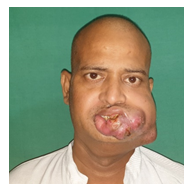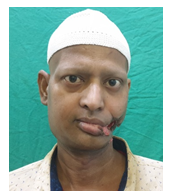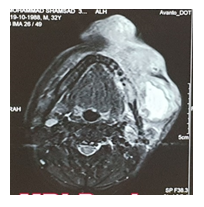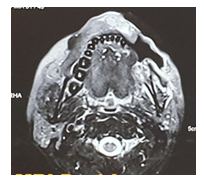Palliative Management of Unresectable Oral Carcinoma by Laser Ablation and Chemotherapy- Case Report
Article Information
Rusy Bhalla1*, Seemantini Bhalla2, Ashish Kapadia3, Parag Shah4
1Head of Department of Oncology, Orchid Center for Laser Surgery, Mumbai, India
2Laser Oncosurgeon Department of Oncology, Orchid Center for Laser Surgery, Mumbai, India
3Radiologist, Department of Radiology, Orchid Center for Laser Surgery, Mumbai, India
4Dentist, Department of Dentistry, Orchid Center for Laser Surgery, Mumbai, India
*Corresponding Author: Dr. Rusy Bhalla Head of Department of Oncology, Orchid Center for Laser Surgery, S1 Link Square mall, Opp KFC Linking Road, Bandra west, Mumbai India 400050.
Received: 10 December 2021; Accepted: 04 January 2022; Published: 17 January 2022
Citation: Rusy Bhalla, Seemantini Bhalla, Ashish Kapadia, Parag Shah. Palliative Management of Unresectable Oral Carcinoma by Laser Ablation and Chemotherapy- Case Report. Journal of Cancer Science and Clinical Therapeutics 6 (2022): 032-038.
View / Download Pdf Share at FacebookAbstract
Inoperable and unresectable carcinoma of oral cavity is defined as the tumour which has an extensive infiltration in the buccal tissues. Any operation to remove this tumour involves an extensive surgery in which complete resection is not possible and a significant cancerous tissue is left behind. These patients are administered NACT (neo adjuvant chemotherapy) to decrease the tumour load in hope of making the tumour resectable. In most cases they are administered a combination of chemotherapy and radiation as a means of palliation. Laser ablation can bring down the tumour content predictably by a great extent in a single session. A 28 year old patient presented with a massive buccal carcinoma which was refused resection or any other intervention by major hospitals. He was a chronic tobacco chewer for last 10 years. On presentation he was suffering from pain from 2 months and oral bleeding for 1 week. Laser ablation procedure was performed. His pain subsided in 24 hours and swelling gradually decreased over 2 months. Conclusion: Laser ablation is a new and viable alternative to surgery in selected cases.
Keywords
Laser Ablation; Massive Buccal Carcinoma; Unresectable Oral Carcinoma; Palliation in Oral Carcinoma
Laser Ablation articles; Massive Buccal Carcinoma articles; Unresectable Oral Carcinoma articles; Palliation in Oral Carcinoma articles
Laser Ablation articles Laser Ablation Research articles Laser Ablation review articles Laser Ablation PubMed articles Laser Ablation PubMed Central articles Laser Ablation 2023 articles Laser Ablation 2024 articles Laser Ablation Scopus articles Laser Ablation impact factor journals Laser Ablation Scopus journals Laser Ablation PubMed journals Laser Ablation medical journals Laser Ablation free journals Laser Ablation best journals Laser Ablation top journals Laser Ablation free medical journals Laser Ablation famous journals Laser Ablation Google Scholar indexed journals Massive Buccal Carcinoma articles Massive Buccal Carcinoma Research articles Massive Buccal Carcinoma review articles Massive Buccal Carcinoma PubMed articles Massive Buccal Carcinoma PubMed Central articles Massive Buccal Carcinoma 2023 articles Massive Buccal Carcinoma 2024 articles Massive Buccal Carcinoma Scopus articles Massive Buccal Carcinoma impact factor journals Massive Buccal Carcinoma Scopus journals Massive Buccal Carcinoma PubMed journals Massive Buccal Carcinoma medical journals Massive Buccal Carcinoma free journals Massive Buccal Carcinoma best journals Massive Buccal Carcinoma top journals Massive Buccal Carcinoma free medical journals Massive Buccal Carcinoma famous journals Massive Buccal Carcinoma Google Scholar indexed journals Unresectable Oral Carcinoma articles Unresectable Oral Carcinoma Research articles Unresectable Oral Carcinoma review articles Unresectable Oral Carcinoma PubMed articles Unresectable Oral Carcinoma PubMed Central articles Unresectable Oral Carcinoma 2023 articles Unresectable Oral Carcinoma 2024 articles Unresectable Oral Carcinoma Scopus articles Unresectable Oral Carcinoma impact factor journals Unresectable Oral Carcinoma Scopus journals Unresectable Oral Carcinoma PubMed journals Unresectable Oral Carcinoma medical journals Unresectable Oral Carcinoma free journals Unresectable Oral Carcinoma best journals Unresectable Oral Carcinoma top journals Unresectable Oral Carcinoma free medical journals Unresectable Oral Carcinoma famous journals Unresectable Oral Carcinoma Google Scholar indexed journals Palliation in Oral Carcinoma articles Palliation in Oral Carcinoma Research articles Palliation in Oral Carcinoma review articles Palliation in Oral Carcinoma PubMed articles Palliation in Oral Carcinoma PubMed Central articles Palliation in Oral Carcinoma 2023 articles Palliation in Oral Carcinoma 2024 articles Palliation in Oral Carcinoma Scopus articles Palliation in Oral Carcinoma impact factor journals Palliation in Oral Carcinoma Scopus journals Palliation in Oral Carcinoma PubMed journals Palliation in Oral Carcinoma medical journals Palliation in Oral Carcinoma free journals Palliation in Oral Carcinoma best journals Palliation in Oral Carcinoma top journals Palliation in Oral Carcinoma free medical journals Palliation in Oral Carcinoma famous journals Palliation in Oral Carcinoma Google Scholar indexed journals oral cavity cancer articles oral cavity cancer Research articles oral cavity cancer review articles oral cavity cancer PubMed articles oral cavity cancer PubMed Central articles oral cavity cancer 2023 articles oral cavity cancer 2024 articles oral cavity cancer Scopus articles oral cavity cancer impact factor journals oral cavity cancer Scopus journals oral cavity cancer PubMed journals oral cavity cancer medical journals oral cavity cancer free journals oral cavity cancer best journals oral cavity cancer top journals oral cavity cancer free medical journals oral cavity cancer famous journals oral cavity cancer Google Scholar indexed journals neo adjuvant chemotherapy articles neo adjuvant chemotherapy Research articles neo adjuvant chemotherapy review articles neo adjuvant chemotherapy PubMed articles neo adjuvant chemotherapy PubMed Central articles neo adjuvant chemotherapy 2023 articles neo adjuvant chemotherapy 2024 articles neo adjuvant chemotherapy Scopus articles neo adjuvant chemotherapy impact factor journals neo adjuvant chemotherapy Scopus journals neo adjuvant chemotherapy PubMed journals neo adjuvant chemotherapy medical journals neo adjuvant chemotherapy free journals neo adjuvant chemotherapy best journals neo adjuvant chemotherapy top journals neo adjuvant chemotherapy free medical journals neo adjuvant chemotherapy famous journals neo adjuvant chemotherapy Google Scholar indexed journals buccal carcinoma articles buccal carcinoma Research articles buccal carcinoma review articles buccal carcinoma PubMed articles buccal carcinoma PubMed Central articles buccal carcinoma 2023 articles buccal carcinoma 2024 articles buccal carcinoma Scopus articles buccal carcinoma impact factor journals buccal carcinoma Scopus journals buccal carcinoma PubMed journals buccal carcinoma medical journals buccal carcinoma free journals buccal carcinoma best journals buccal carcinoma top journals buccal carcinoma free medical journals buccal carcinoma famous journals buccal carcinoma Google Scholar indexed journals buccal tissues articles buccal tissues Research articles buccal tissues review articles buccal tissues PubMed articles buccal tissues PubMed Central articles buccal tissues 2023 articles buccal tissues 2024 articles buccal tissues Scopus articles buccal tissues impact factor journals buccal tissues Scopus journals buccal tissues PubMed journals buccal tissues medical journals buccal tissues free journals buccal tissues best journals buccal tissues top journals buccal tissues free medical journals buccal tissues famous journals buccal tissues Google Scholar indexed journals cancerous tissue articles cancerous tissue Research articles cancerous tissue review articles cancerous tissue PubMed articles cancerous tissue PubMed Central articles cancerous tissue 2023 articles cancerous tissue 2024 articles cancerous tissue Scopus articles cancerous tissue impact factor journals cancerous tissue Scopus journals cancerous tissue PubMed journals cancerous tissue medical journals cancerous tissue free journals cancerous tissue best journals cancerous tissue top journals cancerous tissue free medical journals cancerous tissue famous journals cancerous tissue Google Scholar indexed journals palliative radiotherapy articles palliative radiotherapy Research articles palliative radiotherapy review articles palliative radiotherapy PubMed articles palliative radiotherapy PubMed Central articles palliative radiotherapy 2023 articles palliative radiotherapy 2024 articles palliative radiotherapy Scopus articles palliative radiotherapy impact factor journals palliative radiotherapy Scopus journals palliative radiotherapy PubMed journals palliative radiotherapy medical journals palliative radiotherapy free journals palliative radiotherapy best journals palliative radiotherapy top journals palliative radiotherapy free medical journals palliative radiotherapy famous journals palliative radiotherapy Google Scholar indexed journals
Article Details
1. Introduction
According to recent data, oral cavity cancer was the most common cancer in men in India accounting for 53,842 cases (11.3% of all cancer cases). Oral cavity cancer was responsible for 36,436 deaths (10.2% of all cancer-related deaths) in men. In women, oral cavity cancer occupied fifth position in terms of incidence with 23,161 cases (4.3% of all cases) and it was fifth most common cause of cancer-related mortality with 15,631deaths (4.8% of all cancer-related deaths).70% of all oral cancer in India are reported in advanced stage(stage3 and 4) [1, 2]. Median survival in patients undergoing palliative radiotherapy is only 5.1 months [3].
Oral cancer is a significant public health problem in India and ranks among the top three cancers accounting for one third of all cancers reported in the country. Though it is easily accessible by examination and modern diagnostic tools, a vast number of patients present in later stages [2]. This is partly due to patients coming from rural areas with limited access to diagnostic facilities and attempting herbal or ayurvedic medication in the hope of eradicating it. Since it is a disease of the lower socio-economic groups there is lack of awareness as well as trying out cheaper options regarding treatment. Hence the late presentation. Early detection offers the best chance of optimal treatment outcomes and long-term control and survival [1]. The leading cause of cancer in the oral cavity in India is chewing tobacco in the form of “gutka” or “paan” and smoking “bidis” or cigarettes and consumption of alcohol. Both these substances are carcinogenic. Sharp teeth or ill-fitting dentures causing irritation of the mucosa may also be responsible. Denture related sores may be colonized by candida or HPV and may contribute to developing oral cancer [1].
2. Patient and Methods
A 28 year old male reported to the Department of Oral Cancer with an ulcero-proliferative lesion in the oral cavity extending on the surface of the face on left side for a period of 6 months. There was a history of tobacco chewing in the form of Gutka several times a day for 10 years prior to presentation. There was no history of smoking. He presented five months after he noticed the lesion which was then very extensive. it was diagnosed as poorly differentiated squamous cell carcinoma on biopsy. Oral hygiene was unsatisfactory. In addition, he had multiple lymph nodes in the ipsilateral neck. The patient presented with a gradual increasing swelling of the left cheek and frequent bleeding episodes from the tumour over 1 month. On examination he had a massive tumour of the left buccal mucosa extending to the upper and lower gingivobuccal sulci, the cheek muscle, angle of mouth and skin. Posteriorly it extended to the RMT(Retro molar trigone. There was total trismus. He had a weight loss of 12 kgs over last 3 months.
Patient had Nasotracheal intubation under GA. The tumour and lymph nodes were ablated using the 980 nm surgical diode by Gigaa lasers under sonography guided imaging. Mouth opening was achieved under anaesthesia by use of mouth opener instruments. Repeated laser ablations were carried out on a weekly basis under local anaesthesia and sonography guided imaging for a period of three months. Enlarged lymph nodes were laserised by using direct ablation technique under sonography control [4]. The first laser was of two hours duration while subsequent procedures under local anaesthesia ranged from 5 to 10 minutes making total of 4x3=12 number of procedures. Concurrent chemotherapy sessions with Cisplatin, Paclitel and 5 FU in standard dose were administered every three weeks for 6 cycles MRI study was carried out every two months after primary procedure to detect regression of the disease.
3. Results
Patient was pain free within 24 hours of primary laser procedure. No bleeding was seen after 24 hours. He was on soft diet within 3 days and full diet within a week. He was discharged after 6 days. His speech improved considerably. Swelling reduced gradually within two months. The lymph nodes regressed to undectable levels within 3 months He got back to normal activity in six weeks and had 4 kg weight gain over 4 months. There was a recurrence which was managed by repeated laserisation under local anesthesia. There was an oral fistula which was plugged with plastic and gauze dressing enabling him to eat from opposite side. The dressing was changed after every meal. Patient lived for 11 months post procedure and died due to unmanageable multiple local recurrences.
Pre laser

Figure 1: Presentation of Patient .Extensive swelling of face and angle of mouth.
Post laser

Figure 2: Post Laser and chemotherapy after 4 months. Resolution of angle of mouth .Resolution of tumour with oral fistula.

Figure 3: MRI scan showing a massive carcinoma involving RMt and outer surface of Face.

Figure 4: MRI Total resolution of the tumour after 4 months.
4. Discussion
The carcinogens in cigarette smoke belong to multiple chemical classes, including polycyclic aromatic hydrocar-bons (PAHs), N-nitrosamines, aromatic amines, aldehydes, volatile organic hydrocarbons, and metals. In addition to these well-established carcinogens, others have been less thoroughly investigated. These include alkylated PAHs, oxidants, free radicals, and ethylating agents. Considerable evidence indicates that in human cancers caused by cigarette smoking, PAHs, N-nitrosamines, aromatic amines, and certain volatile organic agents play a major role. Extensive data in the literature demonstrate the uptake of these carcinogens by smokers. The data confirm the expected presence of metabolites of these substances in the urine of smokers at higher levels than those in nonsmokers [5] The incidence of inoperable cancers presenting in India is much more than operable cancers. Estimates are about 80% of all oral cancers are in stage 4 when they present in India [2]. It is not just lack of medical facilities but also rapid progression of the disease in most cases. The survival rates for inoperable cancers in India are abysmally low.
Most patients have a life span of less than 3 months [6-8]. Even though most discussions separate Quality of life from Quantity of life, they cannot be separated in a surgery which plunges the patient into major changes in his life pattern. Quality index which combines the 2 has been proposed in these cases [9]. Severe mutilation and plunging of Quality of life becomes one of the main reasons for patients delaying surgery for oral cancer. Laser ablation is now recognized as an alternative to excision in many soft tissue tumours. Prognosis is better for small sized lesions and is obviously poor for large unresectable lesions [9]. Laser ablation works by heat induced destruction of cancer cells as well as vascular thrombosis and protein denaturation of cellular proteins of heat affected cells [10, 11]. Judicious use under sonography control can be used to kill a majority of the tumour. This can be followed by chemotherapy for a good palliation and remission (Figure 1-4). Conventionally this stage of patients are managed by chemotherapy and radiation which has an extremely low rate of response. Palliation is added to the term which basically means pain control and airway patency [12]. Since this is end stage disease most patients will not live beyond 2 months at this stage. Remission is the term used for a period of no active cancer. Laser can add a new level of remission for these patients by clearing up the tumour with help of chemotherapy. The quality of life is much better with practically all oral functions intact.
The main limiting factor in assuring a long-term survival in cases of Late stage oral cancer is due the phenomenon known as field cancerisation [13, 14]. Field cancerisation refers to the phenomenon of multiple origins of deposits of genetically altered cells in the oral mucosa which are more prone to turn malignant as time goes by. This phenomenon is more apparent in late stage cancers and in patients ingesting tobacco, Alcohol products. This leads to an inevitable recurrence in the surrounding tissue spaces of a surgically corrected tumor bed with excision and a surgical Flap. This makes any surgery in late stage oral cancer mainly palliative even if carried out with a curative intent with adequate surgical margins [13, 14]. Several studies have emphasized the Limited Quality of Life obtained after mandibular/maxillary removal operations [9]. In our review of literature we could not find any similar case with a full resolution of oral cancer in such an extensive stage. Therefore, we would like to present this case a start of a possible alternative for patients in major unresectable cases of oral cancer.
5. Conclusion
Laser ablation surgery is a powerful new tool for decreasing the tumour load of oral cancer patients in inoperable cancers. The decreased tumour load allows a better chemotherapy effect. Though there will be a marked improvement in swelling and most patients will go into remission, cure is very difficult to achieve in these cases due to field cancerisation. Laser ablation involves specia-lized skills and surgeons need to be trained in this tech-nology for a widespread acceptance of its use in Oncology.
Disclaimer
No funding was received by authors for this study. Permissions were taken for publication of this case.
References
- Three-year Report of Population Based Cancer Registries: 2012-2014. NCDIR (2016).
- Borse V, Konwar AN, Buragohain P. Oral cancer diagnosis and perspectives in India. Sens Int 1 (2020): 100046.
- Veluthattil AC, Sudha SP, Kandasamy S, et al. Effect of Hypofractionated, Palliative Radio-therapy on Quality of Life in Late-Stage Oral Cavity Cancer: A Prospective Clinical Trial. Indian J Palliat Care 25 (2019): 383-390.
- Rusy Bhalla, Seemantini Bhalla, Duleep Bhonsale, et al. Laser Ablation of Metastatic Lymph Nodes in the Neck for Oral Carcinoma-Technique and Viability of the Procedure. Journal of Radiology and Clinical Imaging 4 (2021): 027-035.
- Centers for Disease Control and Prevention (US). National Center for Chronic Disease Prevention and Health Promotion (US). Office on Smoking and Health (US). How Tobacco Smoke Causes Disease: The Biology and Behavioral Basis for Smoking-Attributable Disease: A Report of the Surgeon General. Atlanta (GA): Centers for Disease Control and Prevention (US) (2010).
- Vidisha Tuljapurkar, Harsh Dhar, Aseem Mishra, et al. The Indian scenario of head and neck oncology - Challenging the dogmas. Soth Asian Journal of Cancer 5 (2016): 105-116
- Anna Omena, Vasconcellos Le Campion, Camila Maria, et al. Low Survival Rates of Oral and Oropharyngeal Squamous Cell Carcinoma. J Oral Maxillofac Pathol 22 (2018): 18-26.
- Swati Sharma, Satyanarayana L, Smitha Asthana, et al. Oral cancer statistics in India on the basis of first report of 29 population-based cancer regis-tries. J Oral Maxillofac Pathol 22 (2018): 18-26.
- Rusy Bhalla, Seemantini Bhalla, Duleep Bhon-sale, et al. Laser Ablation Surgery in Late Stage Buccal Cancer. Cancer and Oncology Research 6 (2020): 47-52.
- Lanzafame RJ. Laser/Light Applications in General Surgery. In: Nouri K. (eds) Lasers in Dermatology and Medicine. Cham: Springer (2018).
- Ehsan Azma, Nassimeh Safavi. Diode Laser Application in Soft Tissue Oral Surgery. J Lasers Med Sci. Autumn 4 (2013): 206-211.
- Schena E, Saccomandi P, Fong Y, et al. Laser ablation for cancer: Past, present and future. J Funct Biomater 8 (2017): 19.
- Meenakshi Mohan, Nithya Jagannathan. Oral Field Cancerization: An Update on Current Concepts. Oncol Rev 8 (2014): 244.
- Slaughter Dp, Southwick Hw, Smejkal W. Field cancerization in oral stratified squamous epithelium; clinical implications of multicentric origin. Cancer 6 (1953): 963-968.
